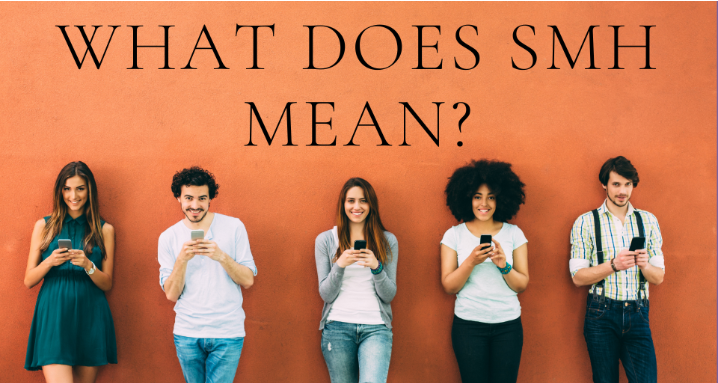Have you ever found yourself scrolling through social media or texting a friend and stumbled upon the acronym “SMH”? If you’re scratching your head wondering what it means, you’re not alone. This three-letter combination has become a staple in digital communication, yet its meaning can sometimes be a mystery. Let’s break it down and get to the bottom of What Does SMH Mean, why it’s used, and how you can incorporate it into your own conversations.
What Does SMH Mean?
SMH stands for “Shaking My Head.” It’s an expression used to convey disappointment, disbelief, or frustration. Imagine shaking your head in disapproval or disbelief—that’s precisely what “SMH” embodies. Whether it’s a reaction to something absurd, frustrating, or just plain silly, “SMH” is the perfect shorthand to express those sentiments.
The Origins of SMH
You might be curious about where “SMH” came from. Like many internet slang terms, it emerged from the early days of online chatting and text messaging. The exact origin is a bit murky, but it’s believed to have gained popularity in the early 2000s. As social media platforms like Twitter and Facebook grew, “SMH” spread like wildfire, becoming a go-to acronym for expressing that universal gesture of shaking one’s head.
How Is SMH Used in Conversations?
Now that we know what “SMH” stands for, how exactly do you use it in a conversation? Let’s dive into some examples to illustrate its versatility.
Reacting to Something Silly:
Imagine your friend tells you they tried to microwave a metal spoon. Your reaction? “SMH, you know you can’t do that!”
Expressing Disappointment:
Your coworker admits they forgot to send an important email. You might respond, “SMH, that email was crucial for our project.”
Showing Disbelief:
A news article reports a bizarre story about a cat becoming the mayor of a small town. You share it with a comment, “Only in 2024, SMH.”
Why Has SMH Become So Popular?
Convenience and Brevity
In our fast-paced digital world, brevity is key. We don’t always have the time or space to write out full sentences to convey our feelings. “SMH” provides a quick and easy way to express complex emotions in just three letters.
Universal Gesture
The act of shaking one’s head is a universal gesture that transcends language barriers. Whether you’re in the US, Japan, or Brazil, shaking your head in disapproval is understood everywhere. “SMH” taps into this universal language, making it widely relatable.
Emotional Impact
“SMH” carries a certain weight of emotion. It’s more than just words; it’s a visual representation of a physical gesture. This adds an extra layer of impact to your messages, allowing you to convey a deeper sense of emotion.
Variations of SMH
Like many popular acronyms, “SMH” has spawned several variations to suit different contexts. Here are a few you might encounter:
SMFH: Shaking My F*ing Head**
When mere disappointment isn’t enough, adding an expletive intensifies the emotion.
SMDH: Shaking My Damn Head
Similar to SMFH, this variation adds emphasis, conveying a stronger sense of frustration.
SMH in GIFs and Memes
In the age of GIFs and memes, “SMH” has found a new life. You’ll often see it paired with animated images of people shaking their heads, adding a visual element to the expression.
When Not to Use SMH
While “SMH” is versatile, there are times when it’s best to avoid using it. In professional settings or formal communications, relying on acronyms can come across as unprofessional. Instead, opt for a more straightforward expression of your feelings.
Additionally, be mindful of your audience. If you’re communicating with someone who might not be familiar with internet slang, “SMH” could lead to confusion rather than clarity.
Incorporating SMH into Your Communication
So, you’re ready to start using “SMH” in your texts and posts. Here are a few tips to do it effectively:
Context is Key: Ensure the context of your message clearly conveys the reason for your disappointment or disbelief. Without context, “SMH” might lose its impact.
Don’t Overuse: Like any slang, overusing “SMH” can diminish its effectiveness. Reserve it for moments that genuinely warrant the expression.
Combine with Other Reactions: Pair “SMH” with other acronyms or emojis to enhance your message. For example, “SMH 😂” can indicate that something is both frustrating and amusing.
Conclusion
In the ever-evolving landscape of digital communication, acronyms like “What Does SMH Mean” offer a convenient and expressive way to convey our emotions. Whether you’re reacting to a friend’s silly mistake or expressing disbelief at the latest news headline, “SMH” is a powerful tool to have in your linguistic arsenal. So next time you’re at a loss for words, give “What Does SMH Mean” a try and see how this simple acronym can add a whole new dimension to your conversations.
